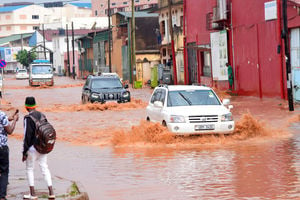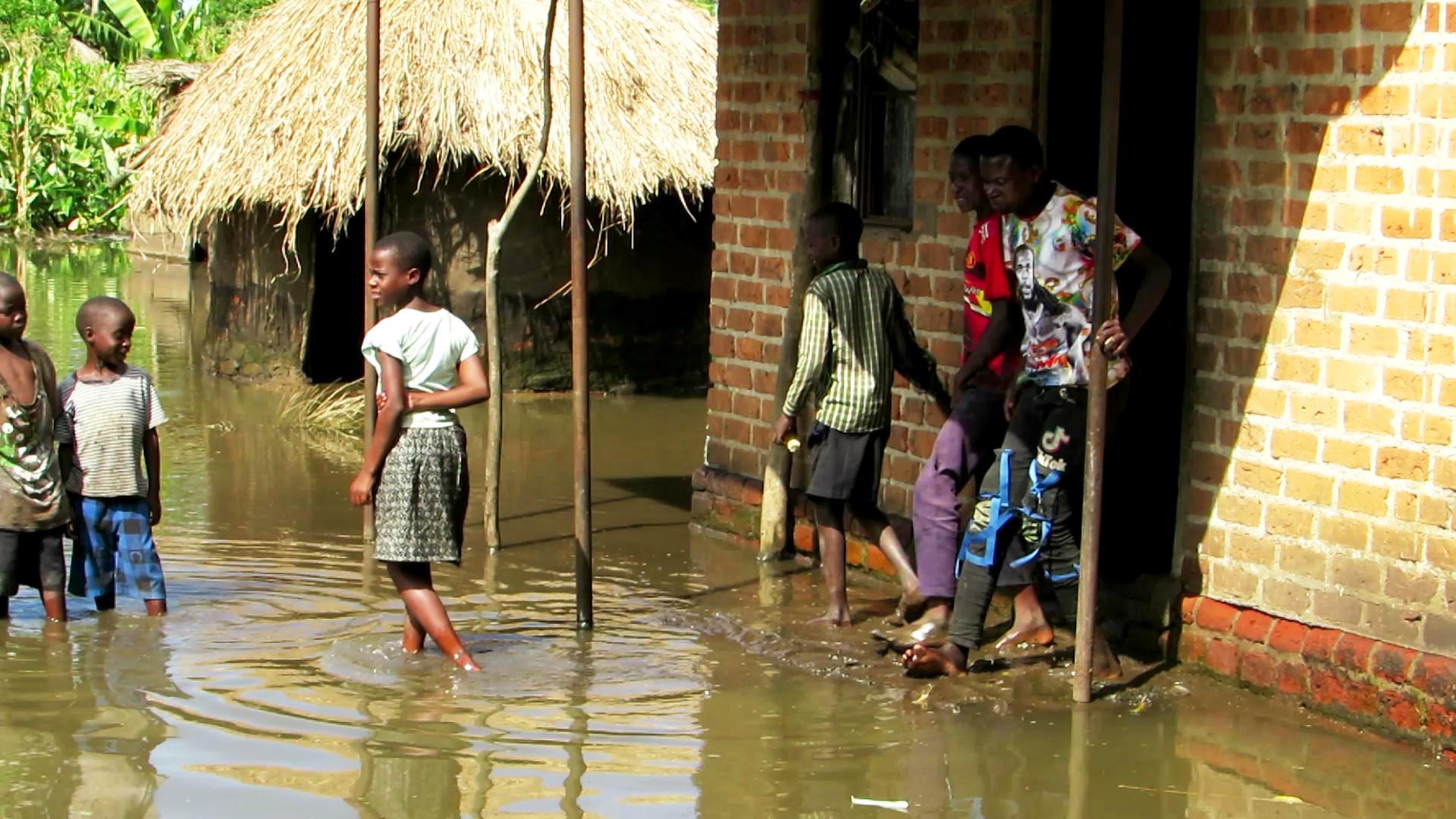
Residents retrieve a car from River Nabuyoga in Mbale City in August 2022. The river burst its banks, causing flash floods that swept cars off Nabuyoga Bridge. At least 11 bodies were found in the car. PHOTO/FILE
Weeks after the landfill tragedy in Kiteezi, hearts remain heavy in Kawempe Division where scores of people were buried as they slept on August 10.
Tens of people are believed to be still missing following the disaster in which the official search for bodies appears to have ended with the death count standing at 35.
While the disaster united the country in grief, state actors swiftly moved to promise that everything remotely possible was being done to ensure lightning does not strike twice. Reports on mitigating calamities are, however, not as sanguine, with their body of work making clear that a radical rethink is needed to protect those beset by disasters in the country. The reports also indicate that the disproportionate impact disasters have, as shown in Kiteezi, are mostly on the vulnerable.
The Value for Money Audit Report on the Preparedness of the Office of the Prime Minister, for one, offers a damning indictment on state actors after running the rule over the three financial years (FY) of 2019/2020, 2020/2021 and 2021/2022. Lessons from previous disasters that evidently reversed social and economic gains, the report notes, were hardly learned.
“The OAG [Office of the Auditor General] conducted a follow-up audit to establish the extent to which the recommendations of the earlier report had been implemented and noted that none of the recommendations had been fully implemented,” the report says of a broken risk perception.
Incompetence
The OAG attributes the deficits to incompetence that continues to blight the Office of the Prime Minister (OPM) to whose care the disaster management component is entrusted. It notes that “although the Department of Disaster Preparedness and Management was filled at 86 percent, only three i.e. 16 percent of the staff attached to this department had training in risk assessment.” The OAG’s report also reveals that “departmental staff also lacked critical skills like geologists, engineers, statisticians, land surveyors and geomatics that are key in conducting hazard profiling and risk assessment.”
Alex Taremwa, the co-founder of the Last Drop Africa, a think tank that dedicates itself to shining the spotlight on climate change issues, told this publication that the needle will only be moved when the country has “qualified people in the right places.”
“There are so many people who understand the science of disaster management. I don't understand why some ministries have had the same people for 10 years and we have not seen anything that they have done in those ministries for all this time,” Mr Taremwa said.
But for a country that finds itself in the throes of patronage and clientelism, such a goal will continue to prove to be elusive. At least, per research findings of civil society organisations (CSO) like Civil Society Budget Advocacy Group (CSBAG).
A brainstorming session the CSO convened in February with 17 local governments from disaster-prone areas found out that the blow of disaster impacts can be lessened if legislation compelling the central government to respond was enacted.
Priorities are, for the most part, not aligned to those facing the greatest risk. To address this shortcoming, Mr Taremwa recommends that "the disaster preparedness [unit]… be separated from [the] refugees [department] because it appears all the money for this unit almost gets swept away by refugees.”
Historical failures
The OAG’s report also illuminates the fact that the OPM is plagued by low funding, with most of the funding drawn through supplementary budget in the course of a running financial year.
“An analysis of the funding trends for managing disasters by the OPM in the last three financial years revealed that 83.3 percent, 30.8 percent and 76.3 percent of the funding for this activity was provided as either supplementary or contingency funds,” the report reads in part.
A failure to reconfigure the way disaster risk is seen and managed saw the government grapple with “an economic loss amounting to Shs563b ($152.2m)” in FY 2019/20 when it budgeted to work with a minuscule Shs83.36b. Experts say such a scenario can only happen when planners isolate the financing disaster risk from other forms of risk management.
This usually gives a skewed outlook of the true cost of disasters. The OAG’s report indicates that disaster-related aid financing in the FYs 2020/2021 (Shs16.26b) and 2021/2022 (Shs49.06b) was just as pitiful.
The Auditor General discovered that the Shs563b loss incurred in FY2019/2020 “was distributed across key sectors, namely, the transport and infrastructure sector affecting mainly roads and bridges – Shs206.73b; commercial and residential housing—Shs154.21b; agriculture—Shs77.37b; education—Shs35.44b; environment and natural resource—Shs33.75b; health—Shs31.86b and water and sanitation—Shs23.88b.”
To insulate itself from such episodes that catch it unawares, the government has been advised to undertake regular social and environmental impact assessments to account for risk and indirect impacts so often neglected in its disaster-related aid financing.
“The audit observed that OPM did not undertake any risk profiling for the three years under review. The last profiling was conducted in 2018 (yet this should be undertaken once every three years) as the basis for producing the latest National Risk and Vulnerability Atlas of 2020,” the report discloses, adding: “OPM has only produced one Annual State of Disaster Report since 2020.”
Risk systems
The OAG also noted that, despite the increasing scale and frequency of disasters in the country, risk systems are conspicuous by their absence.
“The study further observed that the only early warning system managed by OPM in Butaleja was faulty and not dependable and was not providing timely warnings to the communities,” the report reads in part. “According to management, the system has for the past five years been providing false alarms in the form of sirens to the public even during dry seasons, yet it was meant to provide warnings for floods. This was caused by the failure to have a maintenance programme for the existing facilities.”
Flood early-warning systems typically come with flood risk communications, but the OAG discovered that there were several “instances when disasters occurred with OPM having no prior information or expectation of them.”
The audit team pointed to the flash floods in Mbale on July 31, 2022 that caught authorities unawares. Investing in inclusive risk reduction could nip such grim episodes in the bud. For now, though, there remains a lot of work to be done.
“[The] OPM’s response to disaster was always delayed and usually uncoordinated. For instance, when Karamoja [Sub-]region was hit by drought in the months of April to June 2022, resulting in hunger, [the] OPM responded with food relief in mid-July 2022.
The delay to respond resulted into 35 deaths due to starvation in Moroto District,” the report notes.
Post management processes are further plagued by absence of sufficient equipment, with the report revealing that “all the nine districts [earmarked as hotspots] did not have adequate equipment such as graders, excavators, cranes, and drones that are required to ensure OPM is prepared to handle disasters.”
By the time of the review, it was discovered that “the districts/OPM hire equipment from private operators or rely on other agencies such as Uganda National Roads Authority (Unra) in the occurrence of a disaster.” When asked, this was attributed “to failure by OPM to plan for the various equipment that support disaster preparedness and response activities.”
Overall, most faults or deficits emanated from the “absence of [legislation] to enforce key provisions of the National Policy for Disaster Preparedness and Management.”
The Auditor General report as such recommends that “OPM should collaborate with stakeholders who have early warning systems through its Inter-Agency Technical Committee to access the early warning information from their existing systems.”




